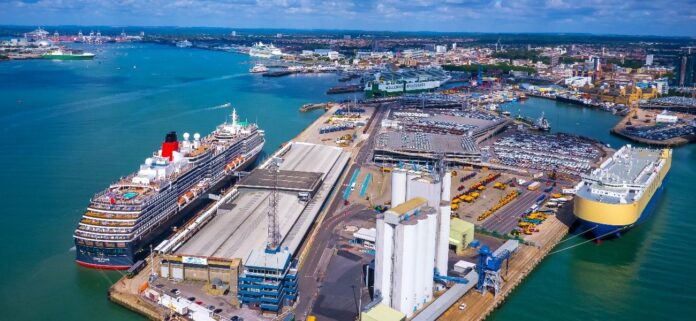What does a port want to get out of a private 5G network? First and most importantly, to solve coverage issues, according to Verizon and Nokia representatives.
In a session at Hannover Messe 2022, Juergen Broemmer of Verizon and Mike Kuczura of Nokia walked the audience through their initial deployment of a private 5G network at the port of Southampton.
Associated British Ports, or ABP, owns and operates 21 ports in the U.K. that account for roughly a quarter of the U.K’s sea trade, including the busy port of Southampton, which handles around 900,000 cars coming into the country, and millions of cruise ship passengers each year.
ABP wanted to do a network transformation project, and it had received some funding from the U.K. government as part of Brexit in order to update its systems. The company wanted “ubiquitous coverage to communicate with people and things throughout the port area,” Broemmer said. “They would have needed hundreds of Wi-Fi access points to do this,” he added, while the private 5G campus network that has been installed relies on just seven 5G radios.
“This was a coverage issue initially. It has multiplied into many other use cases,” affirmed Kuczura of Nokia, which was Verizon’s partner on the project. “When you look at an environment like this, Wi-Fi just really isn’t a good resource to cover this.” Cellular’s penetration and propagation makes a significant difference in the efficiency of the deployment and could operate successfully in a challenging RF environment.
The network uses Verizon’s OnSite 5G solutions, which include Nokia’s NDAC technology. According to Verizon, its new private 5G network at the port works in portions of the expansive east and west docks, consolidating data operations in those areas onto a single network. ABP’s plan was to start with a private 5G network deployment at Southampton, then expand to other ports that it owns and operates.
“When we discuss use cases, sometimes it can be more simple than you think, what the customer is after,” Broemmer said. “Their first and main use case was really connectivity: Connectivity throughout the area of the docks. That’s the first outcome and real benefit that they have, because as you can imagine, a port environment is quite difficult and complex. You have lots of steel, lots of containers. Things are moving, people are moving, they use forklifts, etc., and they have terrible connectivity problems before we rolled out the 5G network. Now, they really have connectivity everywhere.”
Voice service is enabled on the network, and there are already video cameras in use on-site as well, Broemmer said. Additional future use cases under discussion include remote management of on-site cranes, broadband ship-to-shore connectivity and more modern asset tracking capabilities. Broemmer showed images of a massive multi-story structure that was essentially a parking deck for newly arrived cars, which are driven into their places as they are unloaded and scanned for asset tracking. He said that one of the potential use cases being discussed is the ability for certain vehicles (say, a certain American semi-autonomous vehicle manufacturer) to be able to unload and drive themselves to their designated spot, using the 5G network.

